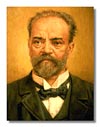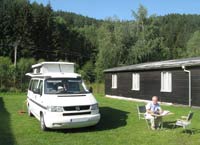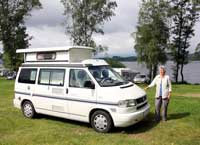|
|
** CZECH REPUBLIC 2009 - Weeks 1~2 ** |
||
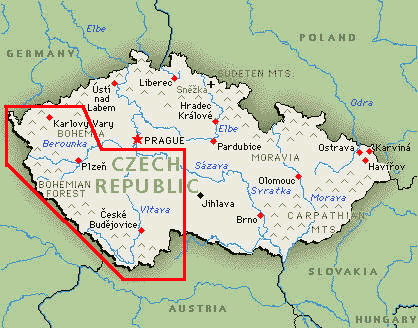 CZECH REPUBLIC
2009 - Western and Southern Bohemia: CZECH REPUBLIC
2009 - Western and Southern Bohemia:Despite autobahn delays due to roadworks, peak holiday traffic and dawdling Dutch caravan convoys, we crossed the Czech border on the third morning of the 700 mile drive from Dunkerque. The former border-control buildings were still in place, but the frontier is now open Schengen-style, and with driving misty drizzle to welcome us, we drove without let or hindrance into Česka Republika, our home for the next 10 weeks.
Our first stop was the small border town of
Cheb, thoroughly German in its origins and architecture, founded as a free
borough by 12th century early waves of German colonists. Eger, as it was known in
German, grew rich from trade but with characteristic German
In leisurely fashion, we ambled around Cheb's elegantly restored central square, námĕstí krále Jiřího z Podĕbrad (does the name Jiřího z Podĕbrad remind you of a Groucho Marx character?), so reminiscent of similar German colonist towns seen last year in Slovakia. The commercial heart of Egerland/Cheb for eight centuries, with the steeply pitched roofs of its houses and the lofty spire of the nearby church of Sv Mikulás peaking over the rooftops, is now surrounded by florally decorated café-terraces. Tesco have made huge inroads in the new East European states, and our final stop in Cheb was to stock up with provisions. The pleasant surprise was that our full trolley load amounted to only 880Kč (around Ł32) but disappointment followed with the check-out lady's blank look when presented with our Tesco's Club Card. The Czech cost of living is still very reasonable: diesel prices are around 25Kč/litre (Ł0.90) and campsite charges are typically Ł10~12/night. The only real problem in early August is that campsites are crowded by the ubiquitous and intemperately noisy Dutch hoards; so if you are a Dutch caravanner reading this, show some respect for others - please moderate you noise and turn your TV down! After a long day, we relaxed in the gathering dusk at the welcoming lakeside Dřenice Camping, with candles twinkling on the supper table; already we felt comfortably settled in Česka, ready to begin serious exploration the following day. Our first stop was the small medieval town of Loket, an attractive gem of a place clustered around its 14th century hrad (castle) set on a fortified craggy outcrop dramatically towering over the surrounding meander of the River Ohře (Photo 1 - 14th century Hrad at Loket). The town square named after T G Masaryk, first President of the new Czechoslovakia in 1918, is surrounded by magnificent Renaissance buildings and in the centre a huge plague column rears skywards (Photo 2 - Central square and plague column at Loket). We moved on to Karlovy Vary, the most
prestigious of West Bohemia's renowned spa towns. Legend has it that in 1350
Emperor Charles IV discovered Karlovy Vary's curative hot springs while out
hunting, hence the German name of the town he founded, Karlsbad. By the
19th century, the spa's location at the meeting point of the Habsburg and
Prussian
Despite all the pretentious air of affluent exclusivity about Karlovy Vary, taking the waters is in fact a most pluralist and democratic affair. Scattered along the shady walkways of the colonnades, simple fonts pour forth the scalding hot mineral water springs into marble basins for all and sundry to fill their little beaker-cups for free and to sip the healing waters which have been the spa's source of wealth for the last 300 years. And sure enough, everyone was at it, filling their little beakers: Japanese tourists doing it very self-consciously and Russian grandes dames doing it with aristocratic aplomb (Photo 6 - Russian lady taking the waters). Not wanting to miss out, we even took a little ourselves, but scalding salty water was not to our taste! It seemed a curious irony that in a place designed to relieve the idle rich of their wealth, access to all the spa-springs was free and open. Slightly disbelieving of the novelty, curiosity and unrestrained ostentation that was Karlovy Vary, we camped that night amid the pine forests further up the valley by the huts of Camping Břzova Haj, a real retro-glimpse into the Czech past, its straightforwardness a million miles from the pretension of the spa town just 3 kms away. On a gloriously sunny morning, we drove further
into Western Bohemia to the industrial city of Plzeň (Pilsen). The city had
expanded rapidly following the establishment of an iron works in 1859. The works
was taken over by the Czech capitalist Emil Škoda, better known for his later
foundation of the Škoda car-making plant. His Pilsen works developed into a
Pilsen's old centre is focused around the main
square, námĕstí Republiky which is dominated by the squat bulk and lofty
spire of Sv Bartolomĕj and surrounded by a grand parade of Renaissance and Art
Nouveau buildings. Nearby stands Pilsen's restored 1888 Great Synagogue with
its onion-domed towers topped by gilded Stars of David. Its 3,500 seating once
accommodated the city's entire pre-war Jewish population, now reduced to a mere
handful by the Holocaust and post-war emigration (Photo 7 - Great Synagogue
at Plzeň). It was here that we learnt an essential Czech word
důchodci, meaning 'pensioner'; most buildings offer reduced admission for
over-60s. We also noticed again the unsmiling, begrudging and ill-gracious
response of those paid to offer service eg TICs, so typical of the Slavic
countries. But as a conclusion to our first afternoon in Pilsen's old centre, we
sat at a bar-terrace in warm sunshine enjoying the chilled, crisp local Pilsner
Urquell pivo (beer), at 30Kč a half-litre (Ł1/pint) as the trams trundled around
the square. This was a worthy prelude to tomorrow's brewery visit. The brewery is approached through its iconic
triumphal arched gateway, built in 1892 to celebrate the beer's 50th
anniversary; the arch as an emblem has figured on
Almost as an afterthought, we visited the Memorial Museum to Pilsen's liberation in May 1945 by the US Army under General George Patton. In typical manner, Patton's tanks had forced a way through Bavaria and in the final days of WW2 had liberated Western Bohemia. Patton was reluctantly compelled to halt at Pilsen to allow the Red Army to take Prague along the demarcation line agreed by the Big Three, Truman, Churchill and Stalin at Yalta, the line which would soon become the Iron Curtain. Patton's undiplomatic but prophetic words at the time "Better to take on the Soviets when we choose than be compelled to later" earned him demotion. The Memorial Museum in Pilsen recalled this little known period at the close of WW2, events which in effect marked the beginning of the Cold War as the Communists took over Czechoslovakia.
Leaving Pilsen past the giant Škoda engineering works, we drove into SW Bohemia.
Our initial experience suggested that Czech driving standards seemed commendably
tolerant,
After a night's stop at Autocamp Kdyné in the Šumava foothills, we continued eastwards across rolling agricultural countryside where fleets of combine harvesters were hard at work gathering this year's ripened cereal crops. Approaching Klatovy, the magnificent towers and spires of its historic centre stood out proudly over the more mundane suburbs and the giant Tesco superstore where we once more shopped. Founded in 1260 by the Přemyslid King Otakar II, Klatovy flourished on the trading route between Bavaria and Bohemia. Its medieval affluence is still evident from the impressive array of churches, towers and grand houses which surround the main square. The Black Tower was built in the 16th century as a look-out post, and it is still possible for those with stout hearts and sound limbs to climb its 76m height for the views over the town and distant forested borderlands beyond the domed spires of the nearby Jesuit church (Photo 12 - Klatovy's spires and rooftops from the Black Tower). Having walked the town's surviving medieval walls, we returned to the square for an ice-cream, struggling to pronounce the unpronounceable word in Czech zmřzlina. The multi-accented Czech language, with its many sounds simply alien to English speakers, is proving so much more difficult than other Slavic languages we have encountered.
A delightful road through hilly pine woods brought us down to the small town of Vimperk, whose wealth derived from the salt trade route from Bavaria into Bohemia showing the importance of salt in the medieval economy. Here was another unassuming town which took great care to welcome visitors with informative and multi-lingual literature about local features. Beyond here, we descended to Husinec, birth village of the 15th century Reformist preacher and Czech national hero, Jan Hus (1372~1415). An admirer of John Wycliffe, Hus' attempts to reform the Catholic Church's profligacy and his opposition to the sale of indulgences to finance papal wars brought Hus into conflict with the Catholic establishment. He was condemned as a heretic and burnt at the stake in 1415, the event which triggered the Hussite Wars of religion so destructive in the Czech lands. You will find it hard to credit, but it took until 1965 before the Vatican finally expunged the sentence of heresy from Hus, 450 years after his execution, providing further evidence of obscene Catholic absurdity. It is worth visiting Hus' memorial museum in his home village to witness the crude abuse of power by the Catholic Church in medieval politics - plus ça change ....
Prachatice is on the face of it an ordinary sort
of town, but its medieval wealth, again derived from the salt trade, was applied
to give its historic centre a unique aesthetic quality. The façades of all the
houses and public buildings surrounding the square are renowned for their
sgraffito-ed decoration. The artistic style of sgraffito, popular in the 16th
century and
After a night's camp at the welcoming Blanicky Mlyn set delightfully amid pine woods, we moved deeper into the Šumava Hills which form a natural border between Czech, Austria and Germany, and distinct watershed between the rivers draining south to the Danube and those flowing northwards eventually into the North Sea via the Elbe. This border became one of the most sensitive regions of the heavily guarded Iron Curtain during the Cold War, totally closed off by the military. The upper reaches of the Vltava River were dammed in the 1950s, creating the 44km long Lake Lipno, the largest artificial lake in the Czech Republic. The military have long since moved out and the tourists moved in to take advantage of the leisure activities that the lake offers. Camping Olšinách set on the shores of Lake Lipno provided a splendid if expensive base for our two day stay (Photo 14 - Shore-side camp at Lake Lipno) and in the evening, we were rewarded with a spectacular sunset across the lake (Photo 15 - Sunset over Lake Lipno).
Leaving Lake Lipno, we headed north for the
exquisite town of Česky Krumlov whose gigantic castle strides along a craggy
outcrop overlooking the historic centre surrounded on three sides by the
meandering and fast-flowing Vlatava river. As always in approaching a town for
the first time, everything seemed bewildering: heavy traffic, confusing road
system, uncertain parking, as well as the bemusing old town crowded with
tourists. The day was overcast with poor light for photography in the
picturesque old town, but it was ideal weather
The family-run Camping Petrášův Dvůr set on the
banks of the swirling Polečnice stream and 3 kms south of the town provided a
perfect base for our visit to Česky Krumlov. We woke to a misty morning after
last evening's cool and dewy air but the sun soon burned off the mist to give a
clear day for exploring Česky Krumlov's old town and castle. From the busy
The cobbled central square with its ornate plague
column and elegant Gothic-Renaissance former town hall leads up into Horní past
the towering Gothic splendour of St Vitus' Church to the beautifully
sgraffito-ed former Jesuit College, now a luxy hotel. And just opposite, a small
terrace-garden gave panoramic views over the steep roofs of the old town and
bend of the river, against the backdrop of the huge castle occupying the long
rocky prominence above the town (Photo 18 - Český Krumlov Castle
above steep roofs of old town). Our second day in the
town was spent visiting the other key attractions - the castle, the Eggenberg Brewery and sampling the brewery's produce over lunch in one of the splendid
traditional pubs.
The
Eggenberg Brewery was founded in 1560 and still claims its brewing methods have
remained unchanged, malting barley in its own malt-house. Its traditional
copper-capped brewing vessels proudly shown to visitors have doubtless been
replaced by more modern methods, but the beer produced is excellent with
distinctive taste, golden amber colour and
subtle hoppy aroma. We treated ourselves to a lunch of grilled Bohemian carp (kapr
na roštu), the traditional Czech Christmas meal,
amid the splendid wooden decor
of the Hospoda na Louži pub in the heart of Česky Krumlov's old town. The
crispy grilled fish was excellent and the Eggenberg beer
provided an equally
excellent accompaniment to our
lunch (Photo 20 - Eggenberg beer brewed
in Český Krumlov - na zdravi (cheers)!).
| |||||||||||||||||||||||||||||||||||

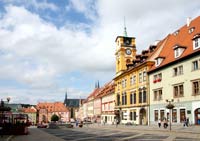 chauvinism resisted
19th century advances in Czech nationalism. In the 1930s, Egerland/Cheb became
the focus of the pro-Nazi Sudeten German Party, welcoming Hitler's annexation of
Czechoslovakia into the Third Reich. But 1945 brought cum-uppance for the Sudeten
Germans of Cheb with the forced expulsion of all ethnic Germans from the
liberated Czech state, reducing Cheb to 27% of its pre-war population. Today
Germans flock back to Cheb as day trippers, some as evident kerb-crawling
clientele of the obvious prostitutes perambulating the town's back-streets. The other curiosity of these small
Czech towns is the presence of Vietnamese stall traders whose cheap wares spill
out onto the pavements.
chauvinism resisted
19th century advances in Czech nationalism. In the 1930s, Egerland/Cheb became
the focus of the pro-Nazi Sudeten German Party, welcoming Hitler's annexation of
Czechoslovakia into the Third Reich. But 1945 brought cum-uppance for the Sudeten
Germans of Cheb with the forced expulsion of all ethnic Germans from the
liberated Czech state, reducing Cheb to 27% of its pre-war population. Today
Germans flock back to Cheb as day trippers, some as evident kerb-crawling
clientele of the obvious prostitutes perambulating the town's back-streets. The other curiosity of these small
Czech towns is the presence of Vietnamese stall traders whose cheap wares spill
out onto the pavements.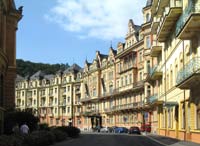 Empires, and its much-promoted efficacious waters, made Karlovy Vary
the place to be seen by the high society of the day. Anyone who was anyone
came to Karlsbad for its cures: Goethe, Beethoven, Tsar Peter the Great, Chopin,
Bismarck; even Karl Marx took time off from his socialistic musings to indulge
in the ultra-capitalist pastime of taking the waters at Karlsbad. This most
illustrious of the West Bohemian spa
Empires, and its much-promoted efficacious waters, made Karlovy Vary
the place to be seen by the high society of the day. Anyone who was anyone
came to Karlsbad for its cures: Goethe, Beethoven, Tsar Peter the Great, Chopin,
Bismarck; even Karl Marx took time off from his socialistic musings to indulge
in the ultra-capitalist pastime of taking the waters at Karlsbad. This most
illustrious of the West Bohemian spa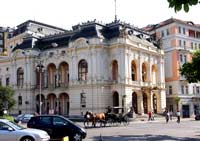 towns is graced with Belle Époque
mansions, grand hotels and spa buildings along the winding course of the River
Teplá (Photo 3 - Spa
town of Karlovy Vary). Despite the post-1945 forced expulsion of the
predominantly German population, tourist expansion even during the Communist era
maintained the spa's prestigious position. Its international clientele is now
dominated by Russian nouveaux riches; signs in Cyrillic are to be seen
throughout the town and Russian was the predominant language heard spoken. The
further we walked along the embankment, the more opulent and extravagantly
bizarre the surroundings became; to witness this undisguised and ostentatious
display of crude affluence was a grotesque experience. Souvenir shops were
crammed with the small spouted beaker-cups from which to sip the hot spa waters.
The spa's most renowned buildings are the colonnades which offer shady cover for
those shuffling up and down while sipping the waters. The most elegant is the
Market Colonnade built in the late 19th century as a temporary structure but
whose delicate white-painted wooden fretwork still stands imperiously (Photo
4 - Market Colonnade (Tržní kolonáda) at Karlovy Vary spa). The most
powerful of the hot spa-springs spurts forth as a geyser some 50 feet into the
air within a modernistic glass rotunda; 2,500 gallons of steaming 60°C salty
water every hour (Photo 5 - Geyser
Colonnade at Karlovy Vary).
towns is graced with Belle Époque
mansions, grand hotels and spa buildings along the winding course of the River
Teplá (Photo 3 - Spa
town of Karlovy Vary). Despite the post-1945 forced expulsion of the
predominantly German population, tourist expansion even during the Communist era
maintained the spa's prestigious position. Its international clientele is now
dominated by Russian nouveaux riches; signs in Cyrillic are to be seen
throughout the town and Russian was the predominant language heard spoken. The
further we walked along the embankment, the more opulent and extravagantly
bizarre the surroundings became; to witness this undisguised and ostentatious
display of crude affluence was a grotesque experience. Souvenir shops were
crammed with the small spouted beaker-cups from which to sip the hot spa waters.
The spa's most renowned buildings are the colonnades which offer shady cover for
those shuffling up and down while sipping the waters. The most elegant is the
Market Colonnade built in the late 19th century as a temporary structure but
whose delicate white-painted wooden fretwork still stands imperiously (Photo
4 - Market Colonnade (Tržní kolonáda) at Karlovy Vary spa). The most
powerful of the hot spa-springs spurts forth as a geyser some 50 feet into the
air within a modernistic glass rotunda; 2,500 gallons of steaming 60°C salty
water every hour (Photo 5 - Geyser
Colonnade at Karlovy Vary).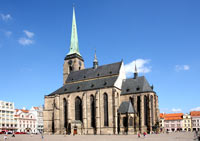 vast
steel, armaments and heavy engineering complex which is still the city's major
employer. But our reason for coming to Pilsen was the city's other major
industry - brewing. The Pilsen Brewery is home to the renowned Pilsner Urquell
beer (Plzeňsky Prazdroj), which has given its name to similar crisp, amber,
foaming-headed lager-beers throughout the world. But of course there is only one
Pilsner Urquell, meaning 'the original', distinguished from its
vast
steel, armaments and heavy engineering complex which is still the city's major
employer. But our reason for coming to Pilsen was the city's other major
industry - brewing. The Pilsen Brewery is home to the renowned Pilsner Urquell
beer (Plzeňsky Prazdroj), which has given its name to similar crisp, amber,
foaming-headed lager-beers throughout the world. But of course there is only one
Pilsner Urquell, meaning 'the original', distinguished from its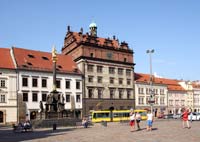 lesser rivals by
its unique quality and taste. For any true lover of beer, a pilgrimage to the Pilsen Brewery is a must.
lesser rivals by
its unique quality and taste. For any true lover of beer, a pilgrimage to the Pilsen Brewery is a must. about declining standards of Pilsen beer caused the city's brewers to band
together and form a joint venture.
about declining standards of Pilsen beer caused the city's brewers to band
together and form a joint venture. The Bavarian Josef Groll was retained as
brew-master; he re-designed the brewing process and produced the first
bottom-fermented, golden crisply refreshing beer we know today as Pilsen,
emulated but never bettered by lesser brewers. Through mergers, takeovers, wars
and Communism, the Pilsner Urquell Brewery has grown into the mammoth brewing
concern of today, whose products are of world-wide renown.
The Bavarian Josef Groll was retained as
brew-master; he re-designed the brewing process and produced the first
bottom-fermented, golden crisply refreshing beer we know today as Pilsen,
emulated but never bettered by lesser brewers. Through mergers, takeovers, wars
and Communism, the Pilsner Urquell Brewery has grown into the mammoth brewing
concern of today, whose products are of world-wide renown.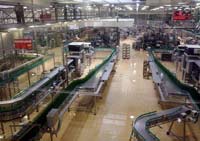 every bottle of authentic
Pilsner Urquell ever since (Photo 8 -
50th Anniversary Arch 1892 at Pilsner Urquell Brewery). Our visit to the
brewery began in the ultra-modern, computer-controlled bottling and canning
plant. From the viewing gallery, we looked down onto the robotic-like 24 hour
operation. Pilsen beer's three ingredients were demonstrated: malted Moravian
barley, water from 100m deep wells and Žatec (Saaz) hops from West Bohemia which
give the beer its characteristic bitter taste and aroma. In the brew-house, the
multi-stage brewing process was explained, and we were shown the huge copper
vessels used successively for mashing, boiling of hopped wort and fermenting (Photo
9 - Copper mash
tuns in Pilsner Urquell brew-house). The 'young' beer is then matured
for 30 days before filtration, pasteurisation and 'packaging' in containers,
bottles or cans for distribution to the waiting thirsty millions. Click here for
an explanation of the
every bottle of authentic
Pilsner Urquell ever since (Photo 8 -
50th Anniversary Arch 1892 at Pilsner Urquell Brewery). Our visit to the
brewery began in the ultra-modern, computer-controlled bottling and canning
plant. From the viewing gallery, we looked down onto the robotic-like 24 hour
operation. Pilsen beer's three ingredients were demonstrated: malted Moravian
barley, water from 100m deep wells and Žatec (Saaz) hops from West Bohemia which
give the beer its characteristic bitter taste and aroma. In the brew-house, the
multi-stage brewing process was explained, and we were shown the huge copper
vessels used successively for mashing, boiling of hopped wort and fermenting (Photo
9 - Copper mash
tuns in Pilsner Urquell brew-house). The 'young' beer is then matured
for 30 days before filtration, pasteurisation and 'packaging' in containers,
bottles or cans for distribution to the waiting thirsty millions. Click here for
an explanation of the 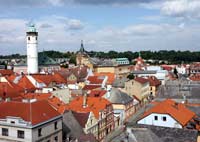 respectful of speed limits and other restrictions making driving less
stressful than we had recently been used to; we hoped this would continue. Our
first stop was at the town of Domažlice, 15 kms from the Austrian border
and one of the few frontier towns to have remained staunchly Czech resisting
centuries of Germanisation. This was due to the surrounding area being a centre
of the Chodové people, a Slavic ethnic group who have retained their own
distinct culture, identity and dialect, having historically been retained by the
Czech crown as border guards in return for freedom from serfdom. The cobbled
main street of Domažlice with its medieval gateway and colourful arcaded shop
frontages was delightful (Photo 10 - Medieval arcaded houses and gate-tower at Domažlice).
The town's museum housed in the restored Chodský Hrad presents displays of the Chodové
people, their colourful folk-costumes and traditional bagpipe instruments (dudy)
(Photo 11 - Traditional Chod wedding costumes in Domažlice Chodský Hrad
museum). Domažlice was a splendid town, rightly proud of its inherited Chod
traditions, and did much to offer visitors an informed view of its
respectful of speed limits and other restrictions making driving less
stressful than we had recently been used to; we hoped this would continue. Our
first stop was at the town of Domažlice, 15 kms from the Austrian border
and one of the few frontier towns to have remained staunchly Czech resisting
centuries of Germanisation. This was due to the surrounding area being a centre
of the Chodové people, a Slavic ethnic group who have retained their own
distinct culture, identity and dialect, having historically been retained by the
Czech crown as border guards in return for freedom from serfdom. The cobbled
main street of Domažlice with its medieval gateway and colourful arcaded shop
frontages was delightful (Photo 10 - Medieval arcaded houses and gate-tower at Domažlice).
The town's museum housed in the restored Chodský Hrad presents displays of the Chodové
people, their colourful folk-costumes and traditional bagpipe instruments (dudy)
(Photo 11 - Traditional Chod wedding costumes in Domažlice Chodský Hrad
museum). Domažlice was a splendid town, rightly proud of its inherited Chod
traditions, and did much to offer visitors an informed view of its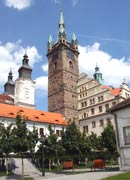 distinctive
past.
distinctive
past.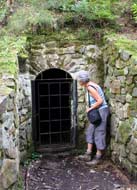 We headed closer into the Šumava Hills up the
Otava valley to Kašperské Hory, an old gold-mining village set high in the
forested hills above the Otava River. Like so many similar Czech places, the town
authorities have gone to great length to provide an informative welcome to its visitors.
We spent a superb afternoon following way-marked footpaths which led past
remains of medieval and later gold workings. Rocky shafts and dark adits showed
the extent of gold-mining around Kašperské Hory; the path traced a delightful 7
kms route around the pine-covered hills. And that night, we received an
excellent welcome at one of the best campsites so far at Klásterský Mlýn set
amid the pine forests of the Otava valley.
We headed closer into the Šumava Hills up the
Otava valley to Kašperské Hory, an old gold-mining village set high in the
forested hills above the Otava River. Like so many similar Czech places, the town
authorities have gone to great length to provide an informative welcome to its visitors.
We spent a superb afternoon following way-marked footpaths which led past
remains of medieval and later gold workings. Rocky shafts and dark adits showed
the extent of gold-mining around Kašperské Hory; the path traced a delightful 7
kms route around the pine-covered hills. And that night, we received an
excellent welcome at one of the best campsites so far at Klásterský Mlýn set
amid the pine forests of the Otava valley.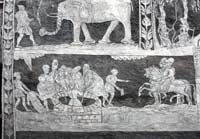 revived in the 19th, involves a foundation layer of evenly painted
plaster facing; this was then scraped away to form geometric or scenic designs
in the white or buff colour of the underlying plaster. The technique was brought
to perfection in Prachatice with the most exquisite examples decorating the
façades of the old town's buildings (Photo 13 - Sgraffito-decorated house at Prachatice).
revived in the 19th, involves a foundation layer of evenly painted
plaster facing; this was then scraped away to form geometric or scenic designs
in the white or buff colour of the underlying plaster. The technique was brought
to perfection in Prachatice with the most exquisite examples decorating the
façades of the old town's buildings (Photo 13 - Sgraffito-decorated house at Prachatice).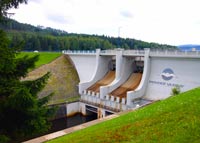 The following day we took the opportunity to visit
the 26m high Lipno dam and the HEP generating station which is driven by the
reservoir waters. The power plant is now operated by the state electrical supply
organisation ČEZ dubiously privatised by the 1989 post-Communist government. The
dam is the first in a series of barrages down the length of the Vltava Cascades,
built not only to generate HEP electrical power but also to control the
destructive flooding along the Vltava River south of Prague which previously
caused regular severe flood damage to farming, houses and industry. We could not
actually visit the Lipno generating station which is hidden in a gigantic
man-made cavern 160m below ground with water from the dam driving its two
turbines. But at the visitor centre overshadowed by the dam, we were shown a
film describing the complex's construction, operation, its contribution to
phasing out a number of environmentally damaging coal-burning power-plants and
its control of flooding further down valley. In the dam's 50 year history, the
Vltava has only flooded once in 2002 whereas before, it was a serious annual
natural hazard. This visit to the dam and its HEP generating station was yet
another to add to our long list of learning experiences.
The following day we took the opportunity to visit
the 26m high Lipno dam and the HEP generating station which is driven by the
reservoir waters. The power plant is now operated by the state electrical supply
organisation ČEZ dubiously privatised by the 1989 post-Communist government. The
dam is the first in a series of barrages down the length of the Vltava Cascades,
built not only to generate HEP electrical power but also to control the
destructive flooding along the Vltava River south of Prague which previously
caused regular severe flood damage to farming, houses and industry. We could not
actually visit the Lipno generating station which is hidden in a gigantic
man-made cavern 160m below ground with water from the dam driving its two
turbines. But at the visitor centre overshadowed by the dam, we were shown a
film describing the complex's construction, operation, its contribution to
phasing out a number of environmentally damaging coal-burning power-plants and
its control of flooding further down valley. In the dam's 50 year history, the
Vltava has only flooded once in 2002 whereas before, it was a serious annual
natural hazard. This visit to the dam and its HEP generating station was yet
another to add to our long list of learning experiences.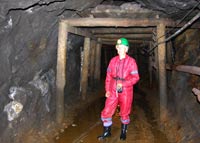 for the town's other unusual
feature, an underground visit to the now closed graphite mine. The Česky Krumlov
Graphite Mine (Grafiový důl) had begun operating as recently as 1975, spanning the
years of the Velvet Revolution and transition from Communist period to market
economy which had finally dealt the mine's death knell; cheaper imports of
graphite from China had caused the mine's closure in 2002. But parts of the
underground workings are now open as a mining museum. Donning overalls, wellies,
hard-hat and battery-lamp, - it was going to be a wet and dirty excursion - the
group of visitors squeezed into the little mine train. This trundled, rattled,
jolted and jarred its way at an alarming speed 1.5 kms into the adit tunnel,
finally coming to a halt for us to emerge into the darkness of the mine just 18m
below the surface. With water dripping from the tunnel roof, we plodged our way
through the mine, pausing for the guide to explain working methods and
equipment. At last we reached a working face where we could smear our fingers
across the waxy black surface of the exposed graphite seam (Photo 16 - Graphite Mining Museum
at Český Krumlov). This feel
serves to explain the material's primary industrial application as a dry
lubricant, a feature of the flat plates of the atomic structure of this form of
pure carbon. So far in our travels we had chalked up mining of lignite, coal,
iron-ore, silver, lead and mercury; here was something new to add to our
industrial heritage experience.
for the town's other unusual
feature, an underground visit to the now closed graphite mine. The Česky Krumlov
Graphite Mine (Grafiový důl) had begun operating as recently as 1975, spanning the
years of the Velvet Revolution and transition from Communist period to market
economy which had finally dealt the mine's death knell; cheaper imports of
graphite from China had caused the mine's closure in 2002. But parts of the
underground workings are now open as a mining museum. Donning overalls, wellies,
hard-hat and battery-lamp, - it was going to be a wet and dirty excursion - the
group of visitors squeezed into the little mine train. This trundled, rattled,
jolted and jarred its way at an alarming speed 1.5 kms into the adit tunnel,
finally coming to a halt for us to emerge into the darkness of the mine just 18m
below the surface. With water dripping from the tunnel roof, we plodged our way
through the mine, pausing for the guide to explain working methods and
equipment. At last we reached a working face where we could smear our fingers
across the waxy black surface of the exposed graphite seam (Photo 16 - Graphite Mining Museum
at Český Krumlov). This feel
serves to explain the material's primary industrial application as a dry
lubricant, a feature of the flat plates of the atomic structure of this form of
pure carbon. So far in our travels we had chalked up mining of lignite, coal,
iron-ore, silver, lead and mercury; here was something new to add to our
industrial heritage experience.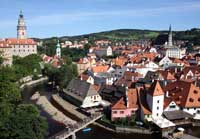
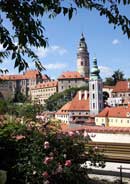 traffic of the modern town's main road, you seem to step through a time warp in
crossing the Vltava river's wooden footbridges: entering the old town's narrow
streets, you are transformed into its medieval past. The almost 360° meander of
the fast-flowing Vltava river encircles the old town (Photo 17 - Český Krumlov old town
and meandering River Vltava), swirling over artificial
rapids which make challenging sport for the young canoeists who flock here to brave the river's foaming descent through the old town. Its all good wet fun
as canoes filled with water capsized, spilling their occupants into the fast
current to the cheers of the tourists lining the embankment.
traffic of the modern town's main road, you seem to step through a time warp in
crossing the Vltava river's wooden footbridges: entering the old town's narrow
streets, you are transformed into its medieval past. The almost 360° meander of
the fast-flowing Vltava river encircles the old town (Photo 17 - Český Krumlov old town
and meandering River Vltava), swirling over artificial
rapids which make challenging sport for the young canoeists who flock here to brave the river's foaming descent through the old town. Its all good wet fun
as canoes filled with water capsized, spilling their occupants into the fast
current to the cheers of the tourists lining the embankment.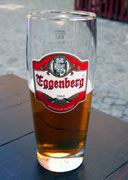 The vast complex of castle buildings, developed over
centuries, spreads along the length of the craggy outcrop towering above the
town and river. Its magnificently painted Round Tower dominates the skyline (Photo
19 - Round Tower at Český
Krumlov Castle) and shows the wealth of the succession
of feudal aristocratic families who had ruled from the castle - the Eggenbergs,
Rožmberks and Schwarzenbergs. The tower's parapet gave more panoramic views over
the old town encircled by the river, with the steep Gothic roofs of St Vitus' Church crowning the highest
point.
The vast complex of castle buildings, developed over
centuries, spreads along the length of the craggy outcrop towering above the
town and river. Its magnificently painted Round Tower dominates the skyline (Photo
19 - Round Tower at Český
Krumlov Castle) and shows the wealth of the succession
of feudal aristocratic families who had ruled from the castle - the Eggenbergs,
Rožmberks and Schwarzenbergs. The tower's parapet gave more panoramic views over
the old town encircled by the river, with the steep Gothic roofs of St Vitus' Church crowning the highest
point.